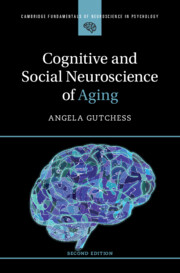Book contents
- Cognitive and Social Neuroscience of Aging
- Cambridge Fundamentals of Neuroscience in Psychology
- Cognitive and Social Neuroscience of Aging
- Copyright page
- Contents
- Figures
- Preface
- Acknowledgments
- Chapter One Introduction to the Cognitive Neuroscience of Aging
- Chapter Two Brain Mechanisms of Aging
- Chapter Three Cognition and Aging
- Chapter Four Memory and Aging
- Chapter Five Emotion, Decision Making, and Aging
- Chapter Six Social Cognition and Aging
- Chapter Seven Alzheimer’s Disease and Other Disorders with Age
- Chapter Eight Current and Future Directions
- References
- Index
- References
Chapter Eight - Current and Future Directions
Published online by Cambridge University Press: 14 February 2025
- Cognitive and Social Neuroscience of Aging
- Cambridge Fundamentals of Neuroscience in Psychology
- Cognitive and Social Neuroscience of Aging
- Copyright page
- Contents
- Figures
- Preface
- Acknowledgments
- Chapter One Introduction to the Cognitive Neuroscience of Aging
- Chapter Two Brain Mechanisms of Aging
- Chapter Three Cognition and Aging
- Chapter Four Memory and Aging
- Chapter Five Emotion, Decision Making, and Aging
- Chapter Six Social Cognition and Aging
- Chapter Seven Alzheimer’s Disease and Other Disorders with Age
- Chapter Eight Current and Future Directions
- References
- Index
- References
Summary
This chapter discusses some of the current trends and promising future directions in the field of cognitive neuroscience of aging. The chapter first discusses recent research investigating the contribution of individual difference factors related to identify, including race, culture, and sex differences. Next, the chapter reviews recent research on neuromodulation, including ways in which noninvasive brain stimulation (e.g., repetitive transcranial magnetic stimulation [rTMS], transcranial direct current stimulation [tDCS], and transcranial alternating current stimulation [tACS]) has been used in an attempt to enhance cognition with age as well as with age-related disorders. This section also considers other approaches to neuromodulation, including deep-brain stimulation and neurofeedback. Finally, discussion of emerging directions considers the importance of investigating aging across the lifespan, studying the intersection of physical health with cognition, exploring the distinction of socioemotional and cognitive domains, and emphasizing the contribution of context with age.
- Type
- Chapter
- Information
- Cognitive and Social Neuroscience of Aging , pp. 216 - 241Publisher: Cambridge University PressPrint publication year: 2025

